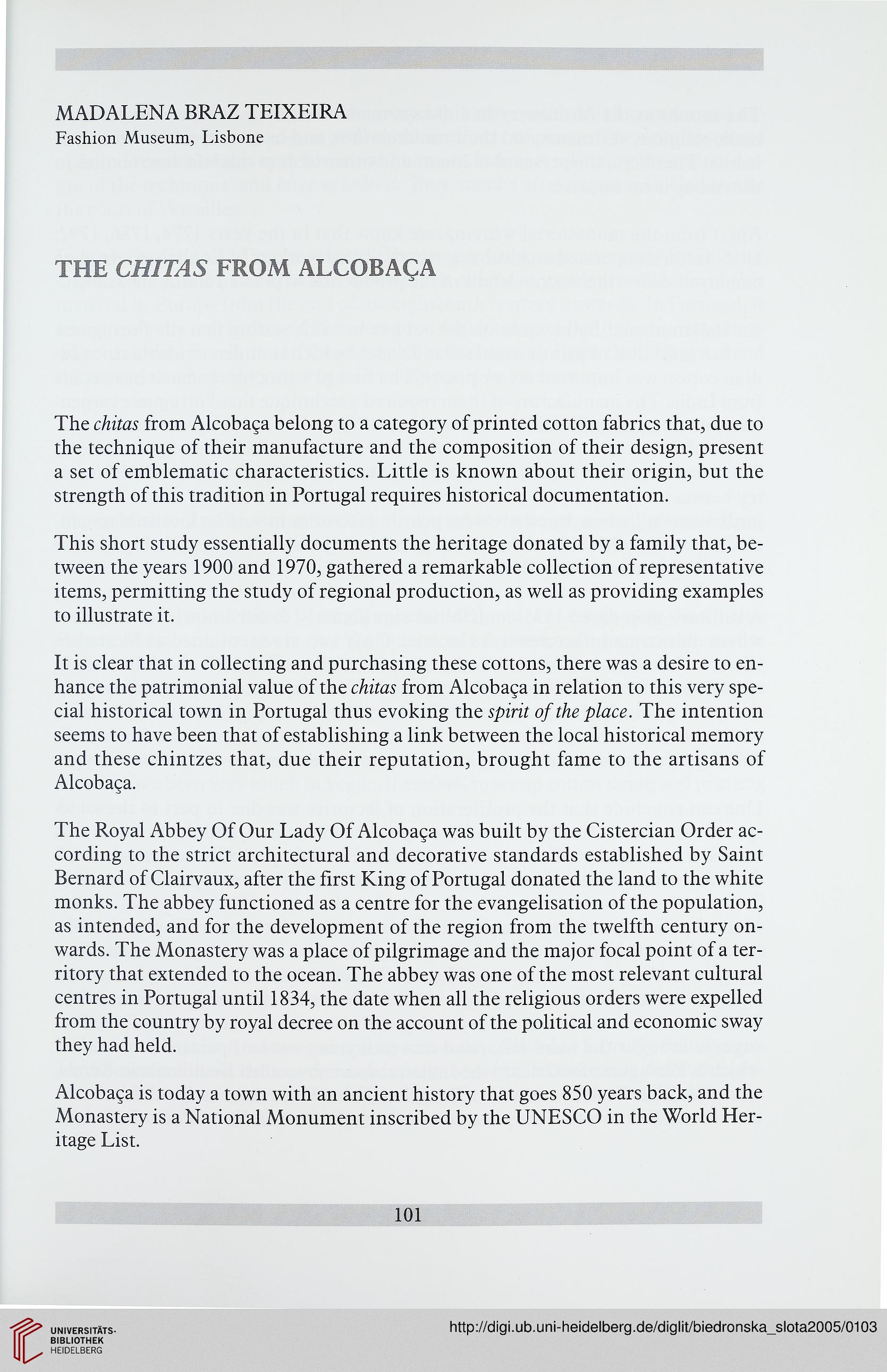MADALENA BRAZ TEIXEIRA
Fashion Museum, Lisbone
THE CHITAS FROM ALCOBAęA
The chitas from Alcobaęa belong to a category of printed cotton fabrics that, due to
the techniąue of their manufacture and the composition of their design, present
a set of emblematic characteristics. Little is known about their origin, but the
strength of this tradition in Portugal reąuires historical documentation.
This short study essentially documents the heritage donated by a family that, be-
tween the years 1900 and 1970, gathered a remarkable collection of representative
items, permitting the study of regional production, as well as providing examples
to illustrate it.
It is elear that in collecting and purchasing these cottons, there was a desire to en-
hance the patrimonial value of the chitas from Alcobaęa in relation to this very spe-
cial historical town in Portugal thus evoking the spirit of the place. The intention
seems to have been that of establishing a link between the local historical memory
and these chintzes that, due their reputation, brought fame to the artisans of
Alcobaęa.
The Royal Abbey Of Our Lady Of Alcobaęa was built by the Cistercian Order ac-
cording to the strict architectural and decorative standards established by Saint
Bernard of Clairvaux, after the first King of Portugal donated the land to the white
monks. The abbey functioned as a centrę for the evangelisation of the population,
as intended, and for the development of the region from the twelfth century on-
wards. The Monastery was a place of pilgrimage and the major focal point of a ter-
ritory that extended to the ocean. The abbey was one of the most relevant cultural
centres in Portugal until 1834, the date when all the religious orders were expelled
from the country by royal decree on the account of the political and economic sway
they had held.
Alcobaęa is today a town with an ancient history that goes 850 years back, and the
Monastery is a National Monument inscribed by the UNESCO in the World Her-
itage List.
Fashion Museum, Lisbone
THE CHITAS FROM ALCOBAęA
The chitas from Alcobaęa belong to a category of printed cotton fabrics that, due to
the techniąue of their manufacture and the composition of their design, present
a set of emblematic characteristics. Little is known about their origin, but the
strength of this tradition in Portugal reąuires historical documentation.
This short study essentially documents the heritage donated by a family that, be-
tween the years 1900 and 1970, gathered a remarkable collection of representative
items, permitting the study of regional production, as well as providing examples
to illustrate it.
It is elear that in collecting and purchasing these cottons, there was a desire to en-
hance the patrimonial value of the chitas from Alcobaęa in relation to this very spe-
cial historical town in Portugal thus evoking the spirit of the place. The intention
seems to have been that of establishing a link between the local historical memory
and these chintzes that, due their reputation, brought fame to the artisans of
Alcobaęa.
The Royal Abbey Of Our Lady Of Alcobaęa was built by the Cistercian Order ac-
cording to the strict architectural and decorative standards established by Saint
Bernard of Clairvaux, after the first King of Portugal donated the land to the white
monks. The abbey functioned as a centrę for the evangelisation of the population,
as intended, and for the development of the region from the twelfth century on-
wards. The Monastery was a place of pilgrimage and the major focal point of a ter-
ritory that extended to the ocean. The abbey was one of the most relevant cultural
centres in Portugal until 1834, the date when all the religious orders were expelled
from the country by royal decree on the account of the political and economic sway
they had held.
Alcobaęa is today a town with an ancient history that goes 850 years back, and the
Monastery is a National Monument inscribed by the UNESCO in the World Her-
itage List.





